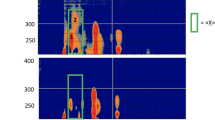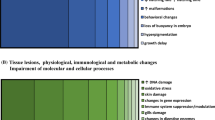Abstract
Methanol extracts of dorsal skin layers, eyes, gills, and livers from ultraviolet-B (UVB) radiation-sensitive and UVB-tolerant species of freshwater fish were examined for a substance that appears to be photoprotective. Significantly larger amounts of this substance were found in extracts of outer dorsal skin layers from both UVB-sensitive and UVB-tolerant fish when compared with extracts of inner dorsal skin layers. This substance occurred in minor amounts or was not detected in eye, gill, and liver extracts. The apparent primary function of this substance in fish is to protect the cells in outer dorsal skin layers from harmful levels of UVB radiation.
Similar content being viewed by others
References
Little, E.E.;D.L. Fabacher: Comparative sensitivity of rainbow trout and two threatened salmonids, Apache trout and Lahontan cutthroat trout, to ultraviolet-B radiation. Arch. Hydrobiol., 43: 217–226 (1994)
Fabacher, D.L.;E.E. Little: Skin component may protect fishes from ultraviolet-B radiation. Environ. Sci. Pollut. Res., 2: 30–32 (1995)
Bullock, A.M.: The pathological effects of ultraviolet radiation on the epidermis of teleost fish with reference to the solar radiation effect in higher animals. Proc. R. Soc. Edinb. 81B: 199–210 (1982)
Blazer, V.S.;D.L. Fabacher;E.E. Little;M.S. Ewing;K.M. Kocan: Effects of ultraviolet-B radiation on fish: histologic comparison of a UVB-sensitive and a UVB-tolerant species. J. Aquat. An. Health, 9: 132–143 (1997)
Karentz, D.;F.S. McEuen;M.C. Land;W.C. Dunlap: Survey of mycosporine-like amino acid compounds in Antarctic marine organisms: potential protection from ultraviolet exposure. Mar. Biol., 108: 157–166 (1991)
Marchant, H.J.;A.T. Davidson;G.J. Kelly: UV-B protecting compounds in the marine algaPhaeocystis pouchetii from Antarctica. Mar. Biol., 109: 391–395 (1991)
Douglas, R.H.;A. Thorpe: Short-wave absorbing pigments in the ocular lenses of deep-sea teleosts. J. Mar. Biol. Ass. U.K., 72: 93–112 (1992)
Chioccara, E.;A. Della Gala;M. De Rosa;E. Novellino;G. Prota: Mycosporine amino acids and related compounds from the eggs of fishes. Bul. Soc. Chim. Belg., 89: 1101–1106 (1980).
Grant, P.T.;P.A. Plack;R.H. Thomson: Gadusol, a metabolite from fish eggs. Tetrahedron Lett., 21: 4043–4044 (1980)
Plack, P.A.;N.W. Frazer;P.T. Grant;C. Middleton;A.I. Mitchell;R.H. Thomson: Gadusol, an enolic derivative of cyclohexane-l,3-dione present in the roes of cod and other marine fish. Biochem. J., 199: 741–747 (1981)
Author information
Authors and Affiliations
Additional information
An erratum to this article is available at http://dx.doi.org/10.1007/BF02986392.
Rights and permissions
About this article
Cite this article
Fabacher, D.L., Little, E.E. Photoprotective substance occurs primarily in outer layers of fish skin. Environ. Sci. & Pollut. Res. 5, 4–6 (1998). https://doi.org/10.1007/BF02986366
Received:
Accepted:
Issue Date:
DOI: https://doi.org/10.1007/BF02986366




